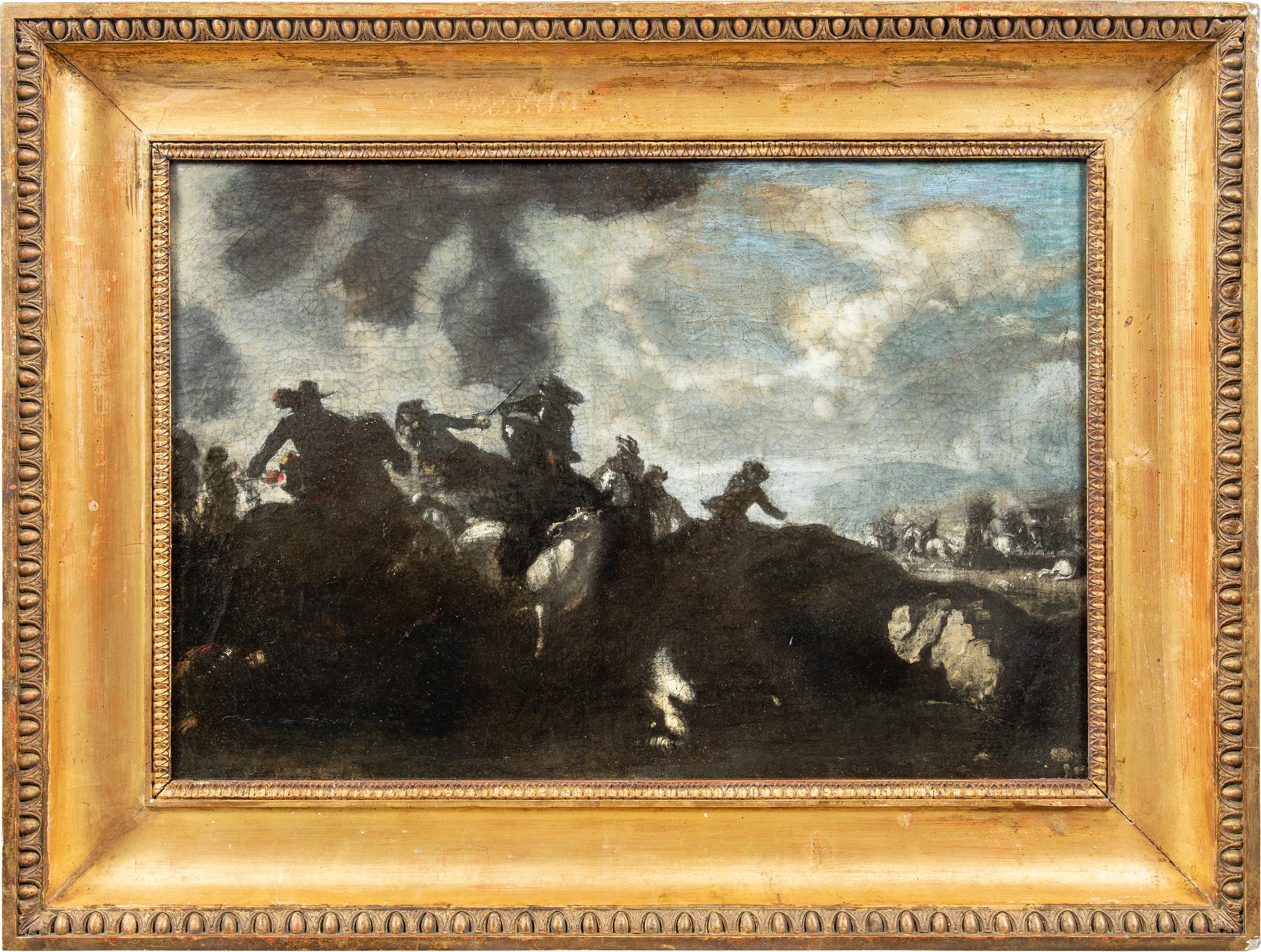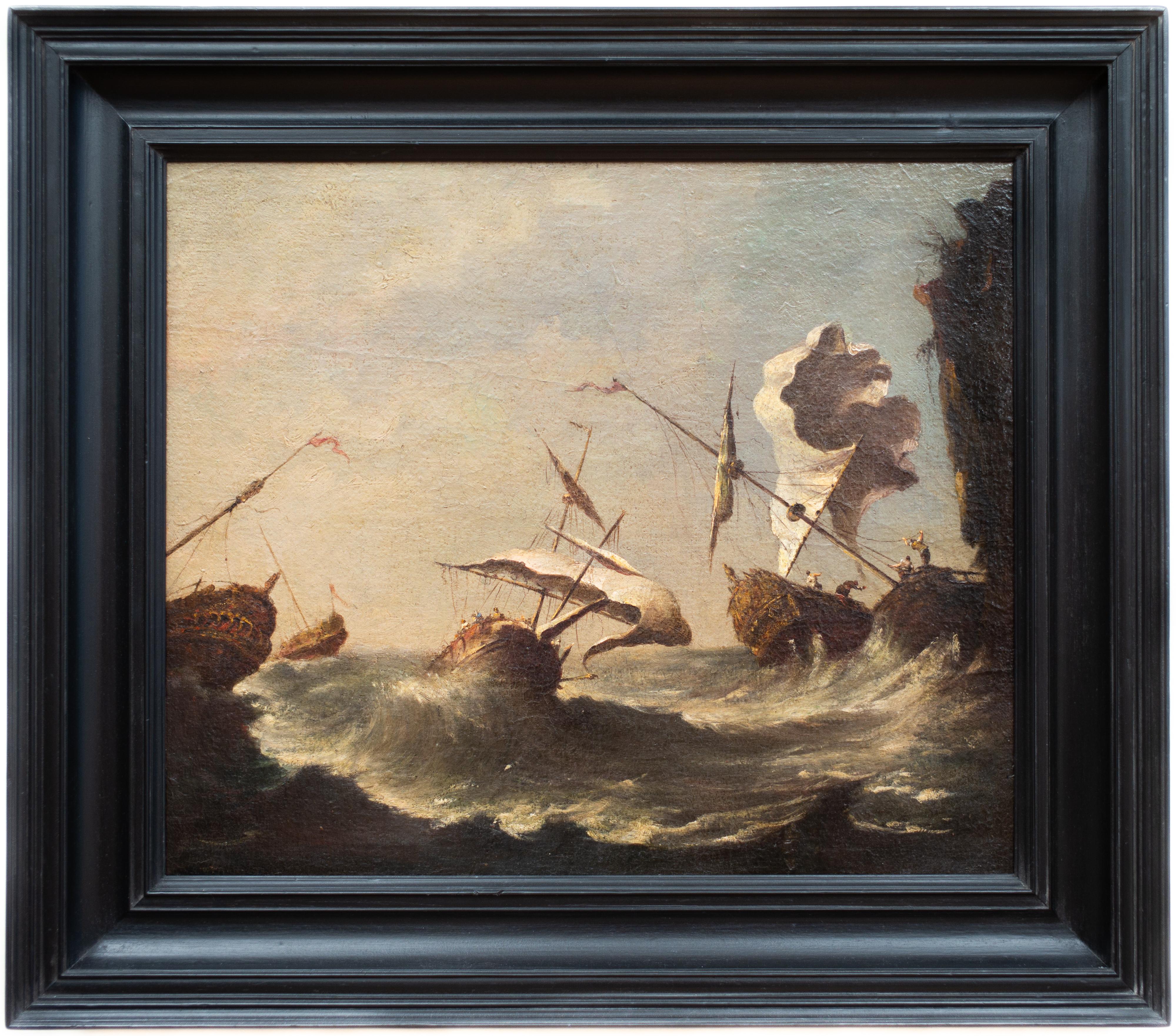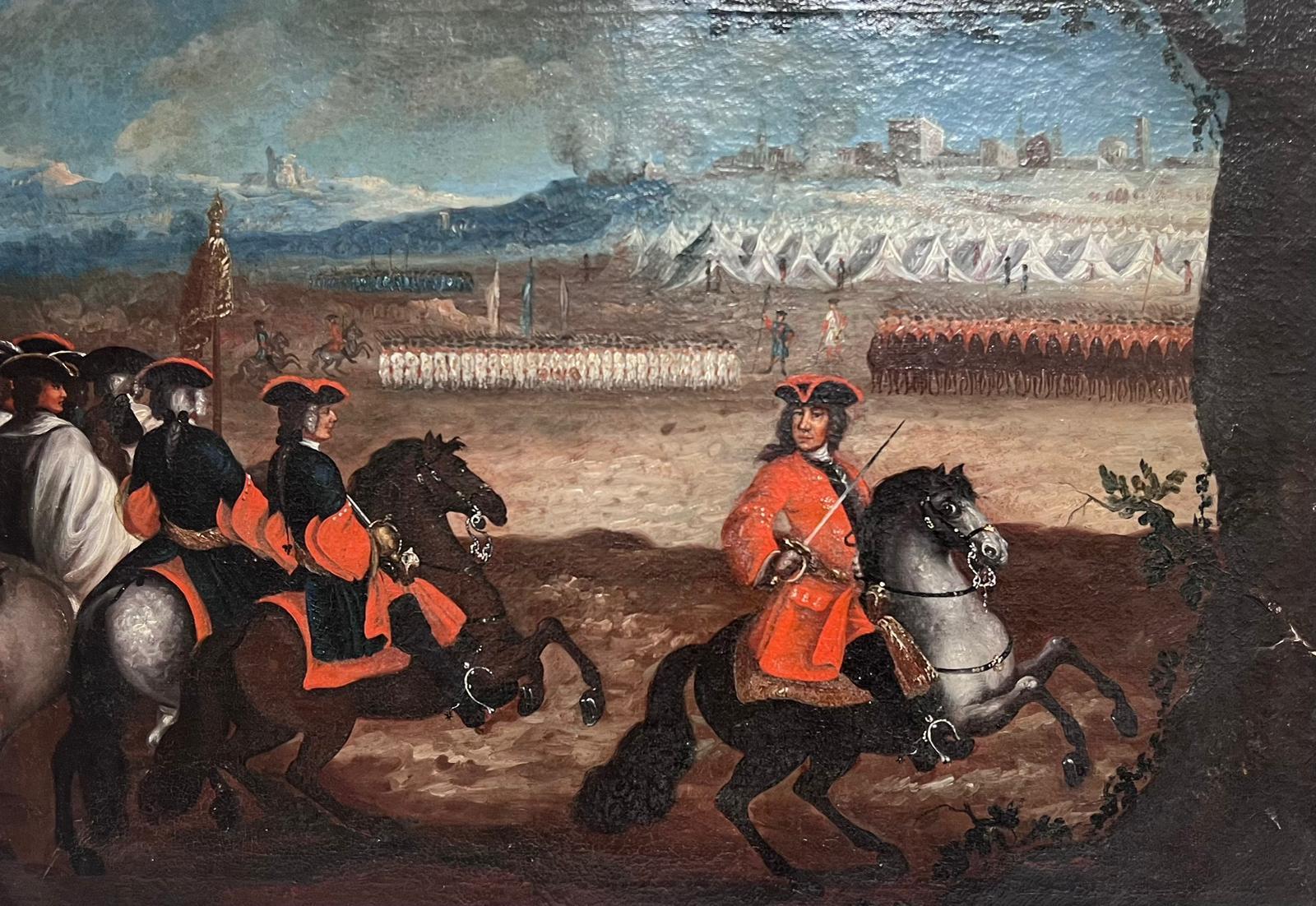Items Similar to Massive 1600's Dutch Golden Age Old Master Oil Painting Figures in Chateau Park
Want more images or videos?
Request additional images or videos from the seller
1 of 8
Massive 1600's Dutch Golden Age Old Master Oil Painting Figures in Chateau Parkc. 1600's
c. 1600's
About the Item
Figures in a Chateau Parkland Court Setting
Dutch Golden Age, early 1600's period
circle of David Vinckboons (Dutch 1576-1632)
oil painting on canvas, unframed
canvas measures: 55 x 82.5 inches (140 x 210cm)
condition: very good and presentable
provenance: from a collection on the French/ German border of Europe.
Substantial and impressive Old Master oil painting from the Dutch Golden Age of the early 17th century. The painting, almost 'tapestry' in its palette and style depicts this grand chateau in a parkland setting with many 'court' figures enjoying the outdoors. Presumably commissioned by the owner of the mansion during their tenure, today it offers incredible interior design possibilities covering a very large area of wall! A very impressive and rare early painting.
Vinckboons was one of the most prolific and popular painters and print designers in the Netherlands. Himself influenced by Pieter Bruegel the Elder, he was instrumental – together with Hans Bol and Roelant Savery – in the development of genre painting in the northern Netherlands.
Vinckboons was born in Mechelen. The family moved to Antwerp around 1580, and then to Middelburg after the Spanish occupation of Antwerp in 1585. It is not likely they moved for religious reasons to Amsterdam. His father became a citizen in 1591, but none of his grandchildren were baptized in a Calvinist church. In 1602, David married in Leeuwarden to Agneta van Loon, the daughter of a notary. Then he lived in Sint Antoniesbreestraat like many other artists and painters. According to Karel van Mander, he did not have any teacher other than his father Phillipe, a painter on canvas with watercolors, an art form practised mainly in his birthplace of Mechelen.
David specialized in elegant figures in park-like landscapes (Outdoor Merry Company, 1610; Vienna, Akademie der Bildenden Künste) as well as Kermis and other village festivals. He also produced Biblical scenes such as Tobias and the Angel (1619, Olana State Historic Site). His landscapes reflect his contact with Gillis van Coninxloo. Vinckboons attracted a number of students; among them were Gillis d'Hondecoeter, Claes Janszoon Visscher and probably Esaias van de Velde.
- Creation Year:c. 1600's
- Dimensions:Height: 55.12 in (140 cm)Width: 82.68 in (210 cm)
- Medium:
- Movement & Style:
- Circle Of:David Vinckboons (1576 - 1632, Dutch)
- Period:Early 17th Century
- Condition:
- Gallery Location:Cirencester, GB
- Reference Number:1stDibs: LU509314282582

About the Seller
5.0
Platinum Seller
These expertly vetted sellers are 1stDibs' most experienced sellers and are rated highest by our customers.
Established in 1989
1stDibs seller since 2016
3,472 sales on 1stDibs
Typical response time: 2 hours
- ShippingRetrieving quote...Ships From: Cirencester, United Kingdom
- Return PolicyA return for this item may be initiated within 3 days of delivery.
More From This SellerView All
- Huge 18th Century Italian Oil Painting Shipping in Merchant Port Many FiguresLocated in Cirencester, GloucestershireThe Merchants Port Italian School, 18th century oil painting on canvas, framed framed: 37 x 58 inches canvas: 32 x 52 inches provenance: private collection, UK condition: very good a...Category
18th Century Old Masters Landscape Paintings
MaterialsCanvas, Oil
- 18th Century Cavalry Military Battle Encampment Soldiers on Horseback French OilLocated in Cirencester, GloucestershireThe Military Encampment French Old Master, circa 1700 oil on canvas, framed framed: 20 x 27 inches canvas: 17.5 x 24 inches provenance: private collection, France condition: very goo...Category
Early 1700s Old Masters Figurative Paintings
MaterialsCanvas, Oil
- Large 18th Century English Old Master Oil Painting Portrait of Lady on canvasLocated in Cirencester, GloucestershirePortrait of a Lady English School, 18th century oil on canvas, unframed canvas : 31 x 25 inches provenance: private collection, UK condition: good and sound conditionCategory
Early 18th Century Old Masters Landscape Paintings
MaterialsOil, Canvas
- Large 18th Century Italian Oil Painting Venice Canal Many Buildings & FiguresBy Francesco GuardiLocated in Cirencester, GloucestershireThe Venetian Canal Italian artist, 18th century circle of Francesco Guardi (Italian 1712-1793) oil on canvas, framed framed: 23.5 x 32.5 inches canvas: 20 x 29.5 inches provenance: p...Category
18th Century Old Masters Landscape Paintings
MaterialsOil, Canvas
- Figures Chatting outside Village Tavern in Mountain Landscape, Period OilBy 19th century Dutch or Flemish schoolLocated in Cirencester, GloucestershireDutch/ Flemish School, early 1800's oil on canvas, framed framed: 19 x 24 inches canvas: 13.5 x 18.5 inches provenance: private collection, France condition: good and sound condition...Category
Early 19th Century Old Masters Landscape Paintings
MaterialsCanvas, Oil
- Early 1800's English Oil Painting Figure in Rural Woodland Landscape, originalBy circle of John ConstableLocated in Cirencester, GloucestershireArtist: English School, early 1800's, circle of John Constable (British 1776-1837) Title: The Woodland Path Medium: oil on canvas, framed Size: 12 x 22 inches Picture: 9 x 18 inches Provence: from a private collection in East Anglia...Category
Early 19th Century Old Masters Landscape Paintings
MaterialsOil, Canvas
You May Also Like
- Antique battle painter - 17th century figure painting Battle KnightBy Jacques CourtoisLocated in Varmo, ITJacques Courtois, known as il Borgognone (Saint-Hyppolite 1621 - Rome 1676) circle of - Battaglia. 53 x 80 cm without frame, 73.5 x 97.5 cm with frame. Antique oil painting on canv...Category
Late 17th Century Old Masters Landscape Paintings
MaterialsOil, Canvas
- The Parade of Swiss Guards a painting on canvas by Gabriel de Saint-AubinLocated in PARIS, FRIn this painting, Gabriel de Saint-Aubin, the great chronicler of the reign of Louis XV, takes us to the annual parade of the Swiss Guards at the Plaine de...Category
1760s Old Masters Figurative Paintings
MaterialsCanvas, Oil
- 17th Century by Simone Cantarini Adoration of The Magi Painting Oil on CanvasLocated in Milano, LombardiaSimone Cantarini (Pesaro 1612 - Verona 1648) Adoration of the Magi Oil on paper applied to canvas, cm. 16,5 x 24 – with frame cm. 22 x 29 Antique sh...Category
Early 17th Century Old Masters Figurative Paintings
MaterialsCanvas, Cotton Canvas, Oil
- Shipping in Stormy Waters, Attributed to Italian Artist Francesco GuardiBy Francesco GuardiLocated in Stockholm, SEThe splendour of the tragic sea Francesco Guardi and maritime painting in Venetian art No Venetian painter was a stranger to the sea. After all, Venice was not only one of the most prominent ports of the Mediterranean, but indeed a city literally submerged in the ocean from time to time. Curiously however, the famous Venetian school of painting showed little interest in maritime motifs, favouring scenes from the iconic architecture of the city rather than seascapes. That is why this painting is a particularly interesting window into not only the painter Francesco Guardi himself – but to the significance of the element of water in art history, in absence as well as in the centre of attention. Whether it be calm, sunny days with stunning views of the palaces alongside the canals of Venice or – more rarely – stormy shipwrecking tragedies at sea, water as a unifying element is integral to the works of painter Francesco Guardi (1712–1793). During his lifetime, Venetian art saw many of its greatest triumphs with names like Tiepolo or Canaletto gaining international recognition and firmly establishing Venice as one of the most vibrant artistic communities of Europe. While the city itself already in the 18th century was something of an early tourist spot where aristocrats and high society visited on their grand tour or travels, the artists too contributed to the fame and their work spread the image of Venice as the city of romance and leisure to an international audience, many of whom could never visit in person. Still today, the iconic image of Venice with its whimsical array of palaces, churches and other historic buildings is much influenced by these artists, many of whom have stood the test of time like very well and remain some of the most beloved in all of art history. It was not primarily subtility, intellectual meanings or moral ideals that the Venetian art tried to capture; instead it was the sheer vibrancy of life and the fast-paced city with crumbling palaces and festive people that made this atmosphere so special. Of course, Venice could count painters in most genres among its residents, from portraiture to religious motifs, history painting and much else. Still, it is the Vedutas and views of the city that seems to have etched itself into our memory more than anything else, not least in the tradition of Canaletto who was perhaps the undisputed master of all Venetian painters. Born into his profession, Francesco lived and breathed painting all his life. His father, the painter Domenico Guardi (1678–1716) died when Francesco was just a small child, yet both he and his brothers Niccolò and Gian Antonio continued in their fathers’ footsteps. The Guardi family belonged to the nobility and originated from the mountainous area of Trentino, not far from the Alps. The brothers worked together on more challenging commissions and supported each other in the manner typical of family workshops or networks of artists. Their sister Maria Cecilia married no other than the artist Giovanni Battista Tiepolo himself, linking the family to the most renowned Venetian name of the time. During almost a decade, Guardi worked in the studio of Michele Giovanni Marieschi, sometimes simply known as Michiel, a painted similar in both style and motif. Canaletto is, however, the artist Guardi is most often compared to since they shared a mutual fascination for depicting the architecture and cityscape of Venice. During the course of his career, Guardi tried his hand in many different genres. He was as swift in painting landscapes, Vedutas of Venice, sacred motifs, interiors and architectural compositions as he was in a number of other motifs. His style is typical of the Venetian school but also distinct and personal once we look a little closer. There is an absolute certainty in the composition, the choice of which sometimes feels like that of a carefully calculated photograph – yet it is also very painterly, in the best sense of the word: fluid, bold, sensitive and full of character. The brushwork is rapid, intense, seemingly careless and extraordinarily minute at the same time; fresh and planned in a very enjoyable mixture. His interiors often capture the breath-taking spacious glamour of the palaces and all their exquisite decor. He usually constructed the motif through remarkably simple, almost spontaneous yet intuitively precise strokes and shapes. The result was a festive, high-spirited atmospheric quality, far away from the sterile and exact likeness that other painters fell victim to when trying to copy Canaletto. The painting here has nothing of the city of Venice in it. On the contrary, we seem to be transported far away into the solitary ocean, with no architecture, nothing to hold on to – only the roaring sea and the dangerous cliffs upon which the ships are just moments away from being crushed upon. It is a maritime composition evoking both Flemish and Italian precursors, in the proud tradition of maritime painting that for centuries formed a crucial part of our visual culture. This genre of painting is today curiously overlooked, compared to how esteemed and meaningful it was when our relationship to the sea was far more natural than it is today. When both people and goods travelled by water, and many nations and cities – Venice among them – depended entirely on sea fare, the existential connection to the ocean was much more natural and integrated into the imagination. The schools and traditions of maritime art are as manifold as there are countries connected to the sea, and all reflect the need to process the dangers and wonders of the ocean. It could symbolize opportunity, the exciting prospects of a new countries and adventures, prospering trade, beautiful scenery as well as war and tragedy, loss of life, danger and doom. To say that water is ambivalent in nature is an understatement, and these many layers were something that artists explored in the most wondrous ways. Perhaps it takes a bit more time for the modern eye to identify the different nuances and qualities of historic maritime paintings, they may on first impression seem hard to differentiate from each other. But when allowing these motifs to unfold and tell stories of the sea in both fiction and reality – or somewhere in between – we are awarded with an understanding of how the oceans truly built our world. In Guardi’s interpretation, we see an almost theatrically arranged shipwrecking scene. No less than five ships are depicted right in the moment of utter disaster. Caught in a violent storm, the waves have driven them to a shore of sharp cliffs and if not swallowed by the waves, crushing against the cliffs seems to be the only outcome. The large wooden ships are impressively decorated with elaborate sculpture, and in fact relics already during Guardi’s lifetime. They are in fact typical of Dutch and Flemish 17th century ships, giving us a clue to where he got the inspiration from. Guardi must have seen examples of Flemish maritime art, that made him curious about these particular motifs. One is reminded of Flemish painters like Willem van de Velde and Ludolf Backhuysen, and this very painting has indeed been mistakenly attributed to Matthieu van Plattenberg...Category
18th Century Old Masters Landscape Paintings
MaterialsCanvas, Oil
- Late 18th century Antique English Moonlight over a lake and church landscapeBy Henry PetherLocated in Woodbury, CTHenry Pether, late 18th-century Moonlight lake Landscape. Born into a family of artists, Henry was the son of Abraham Pether (1756-1812), a talented la...Category
1790s Old Masters Landscape Paintings
MaterialsCanvas, Oil
- The Knight - painting - XVII centuryLocated in Roma, ITThe Knight is an original oil painting on canvas realized during the XVII century by an anonymous artist. Provenance: Pecci-Blunt collection. Good condition...Category
17th Century Old Masters Figurative Paintings
MaterialsCanvas, Oil





